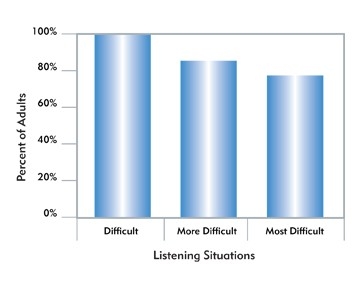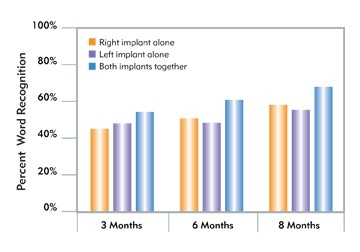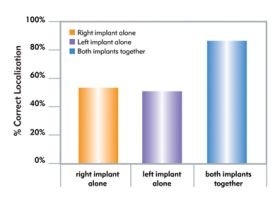
Hearing with Two Ears
You Hear Your Best in Surround Sound
Whether you already have a cochlear implant or you’re considering cochlear implants for the first time, using cochlear implants in both ears (bilateral implantation) provides the best possible hearing.1
Two cochlear implants provide:2,3
- Better hearing in noisy environments, making it easier to hear in noisy offices
- Improved ability to localize sound, making it easier to know the direction of a speaker, honking horn, alarm, etc.
- Greater ease of listening, making it less exhausting to keep up with conversation
- Enhanced sound quality, making it easier to fully appreciate music and more
- No ‘downtime’ in the event of a dead battery or damaged sound processor
Becky’s Journal to Bilateral Hearing
“After going bilateral, I was able to localize sounds, I have no fear of walking on roads, because I can hear cars approaching behind me. I hear in noisy environments, group meetings, and music sounds better.”
— Becky Hague, implanted at age 51, bilaterally implanted at age 52
Two Ears are Naturally Better Than One
Natural hearing is called binaural hearing – “bi” for two, “aural” for ears. Two ears work together to gather the full sphere of sound and deliver it to the brain where it’s almost instantly processed, giving the listener the ability to respond quickly and appropriately. Bilateral implantation merges sound from two ears so that your hearing is better than with one implant alone.
Bilateral Benefits for Every Stage of Life
While the ability to develop language skills is strongest at a young age, adults who have depended on one implant for several years can still experience the many benefits of bilateral implantation.
If you have one “good ear” with your first cochlear implant, consider the additional benefits a second implant can bring. Hearing with two cochlear implants can give you a richer sound with more dimension and improved ability to hear softer sounds.2,3
Adults with two cochlear implants may:
- Hear better in noisy environments like offices and networking events.
- Improve language skills. Bilateral cochlear implants deliver surround sound to your brain for improved speech and language development.
- Localize sound sources more easily. You are better able to determine the location of a sound, like a friend’s “hello” or a fire alarm, and turn to it – giving you more confidence in social situations – and giving you a greater peace of mind.
- Listen with less effort. Less listening effort means you can concentrate on enjoying friends and family.
- Sit anywhere to hear your best. You don’t have to think about positioning yourself so your implanted ear is the closest to what you are trying to hear.
Clinical research shows that two cochlear implants greatly improve your or your child’s ability to hear and understand speech better in noisy environments like meetings, lively classrooms, and bustling restaurants.1
Two cochlear implants help adults interact with friends and business associates at noisy restaurants or clamorous parties. Adults who use two cochlear implants hear much better in noise compared to those with just one.
Percent of adults showing better scores with two implants compared to one implant for three tests of listening to speech in noise of varying difficulties.1

Adults with cochlear implants can understand speech better with two implants compared to listening with one implant alone – even in quiet settings. From romantic dinners to parent-teacher conferences, bilaterally implanted adults recognize more spoken words.
Average word scores in quiet 3, 6, and 8 months after implantation for 15 adults implanted in both ears at the same time. Understanding speech is easier with two implants, and improves with experience.1

From ambulance sirens to honking car horns, two cochlear implants help adults more accurately determine where sound is coming from, just like their normal-hearing peers.
Left vs. right localization accuracy for the right implant alone, left implant alone, and both implants together. Localization is improved significantly when using two implants.1

AB has provided a list of common questions. However, if you have a question you don’t see answered here, contact the AB office in your region.
- Are the candidacy guidelines different for bilateral cochlear implant recipients?
No, the guidelines are the same whether consideration is for one or two cochlear implants. To see if you or your child may be a candidate. - Can the brain bring the two sounds together, even if it’s been a long time since I received my first implant?
There is no reason to wait on choosing bilateral hearing. In children, the sooner they have access to sound, the better the outcome. For older children, teens, and adults, experience with the second implant is key for the best hearing experience possible.3 Many individuals new to bilateral listening can notice an immediate benefit – which improves over time – including clearer speech, ease of listening, a more nautral sound quality, and a new appreciation for music. - What would the advantage of going bilateral be for my child now as they hear very well and test normally with the first implant?
Testing normally in the clinic and hearing well in the real world are not the same. An implant in one ear cannot compensate for hearing with two ears. Remember that hearing with two ears provides many advantages – less stress and fatigue locating the source of sound, hearing more clearly in noise, and enjoying a richer experience with music. - My child still has residual hearing in his/her non-implant ear, is it better to have a hearing aid in this ear than another cochlear implant?
Residual hearing doesn’t mean useable hearing, even with a hearing aid. The best way to know if an ear may benefit from a cochlear impalnt is to be evaluated by an audiologist. If you are unsure of whether or not you might be a candidate for bilateral cochlear implants, contact the AB office in your region. - Will the implantation be quicker than for my first implant?
The implantation experience is unique to each individual. Like technology, implantation practices can change and improve. We recommend that each person considering a cochlear implant discuss the implantation procedure and expectations with the implant team and audiolgist. You can also visit our pages that discuss Implantation & Recovery and Initial Activation. - How will my second implant be financed?
Financing options and insurance coverage vary by region. Contact the AB office in your area to learn more.
References
Koch DB, Soli SD, Downing M, and Osberger MJ. 2009. Simultaneous Bilateral Cochlear Implantation: Prospective Study in Adults. Cochlear Implants International (February 26), Cochlear Implants International, n/a. doi: 10.1002/cii.413
Zeitler D, et al. 2008. Speech Perception Benefits of Sequential Bilateral Cochlear Implantation in Children and Adults: A Retrospective Analysis. Otology & Neurotology. 29 (3): 314–325.
Dunn, C, et al. 2008. Comparison of Speech Recognition and Localization Performance in Bilateral and Unilateral Cochlear Implant Users Matched on Duration of Deafness at Age of Implantation. Ear and Hearing. 29 (3): 352–359
Balkany T, Hodges A, Telischi F, et al. 2008. William House Cochlear Implant Study Group: Position Statement on Bilateral Cochlear Implantation. Otology & Neurotology. 29: 107–108.


